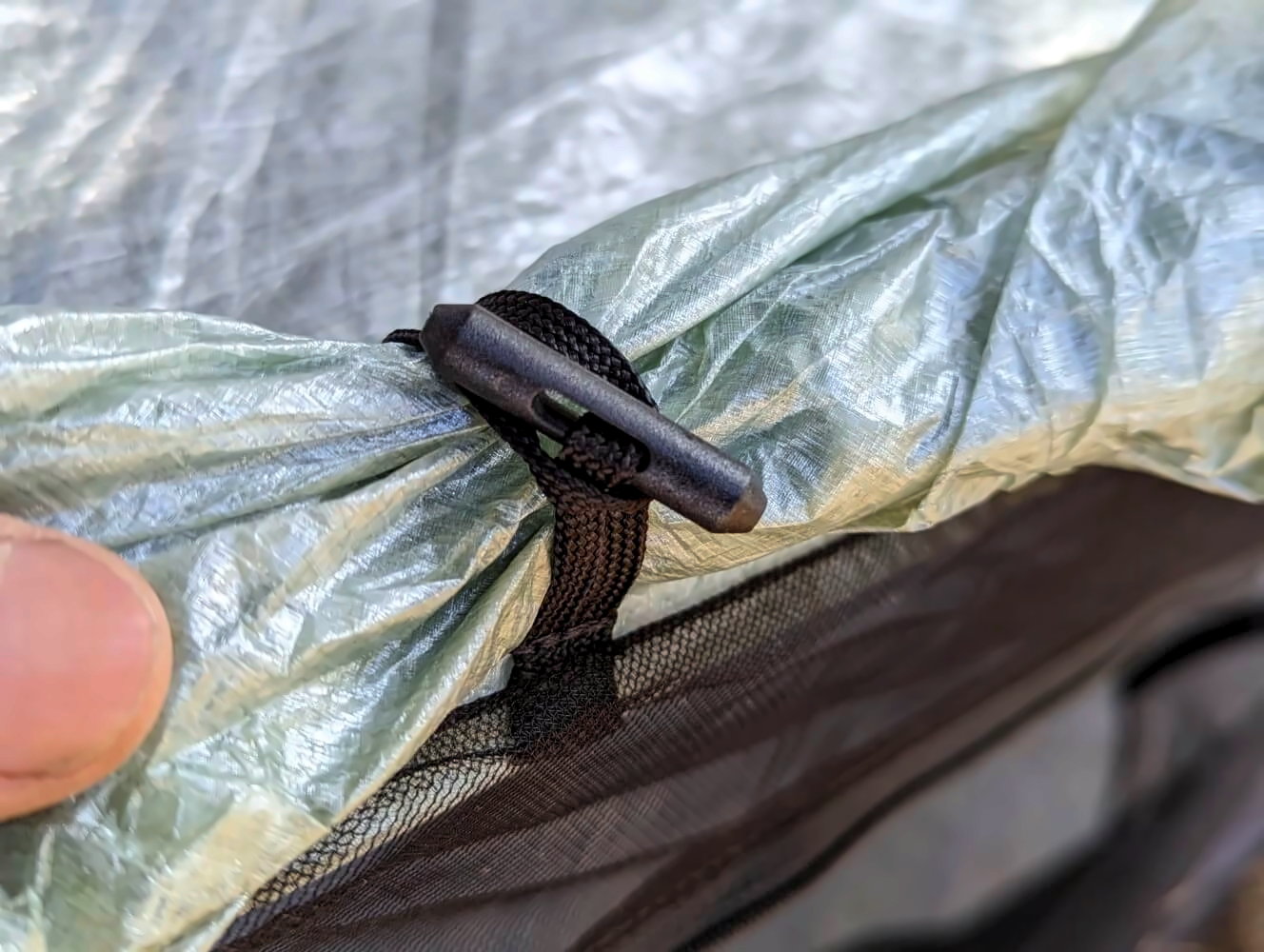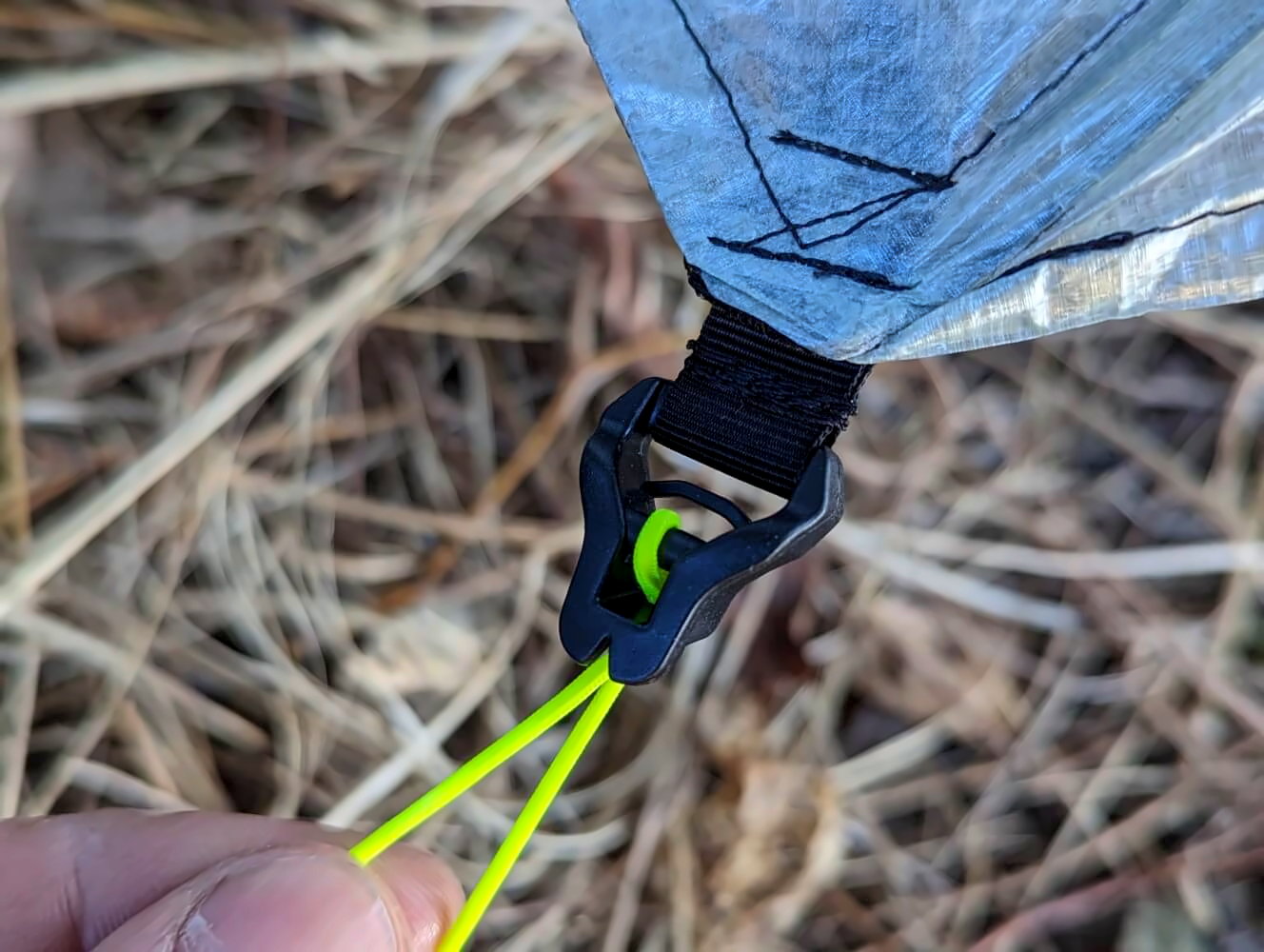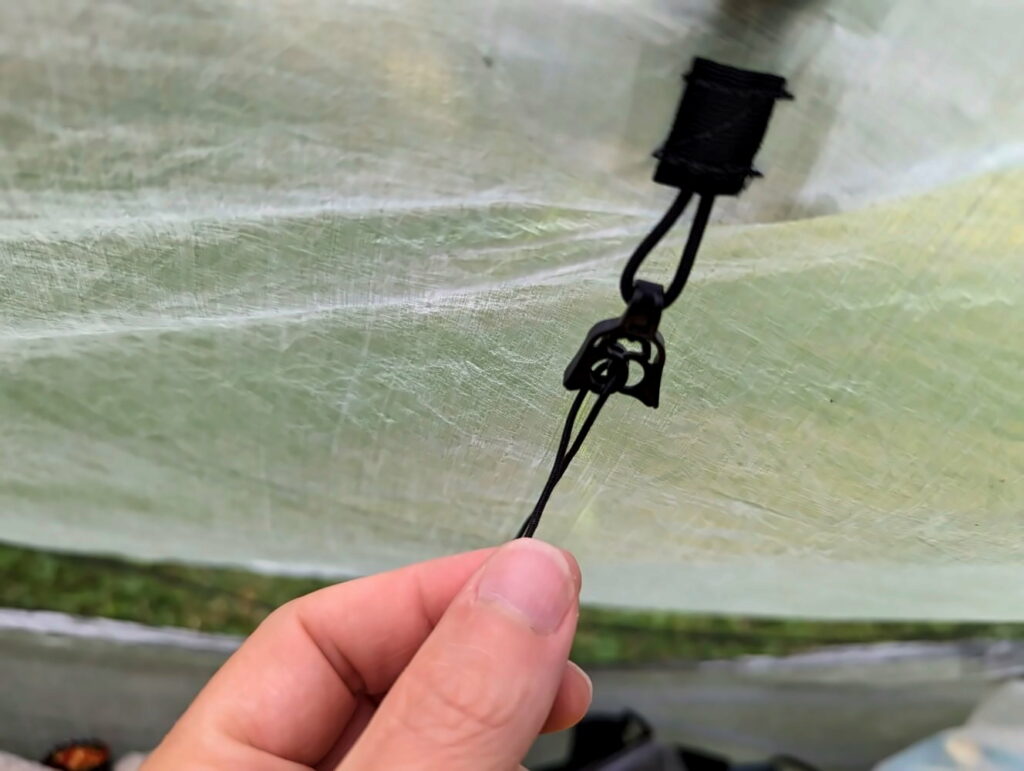- Zpacks Duplex Lite at a glance
- Construction of the Zpacks Duplex Lite
- How to setup the Duplex Lite
- Reliable Weather Protection
- How much space does the Duplex Lite offer?
- Weather resistance of the Duplex Lite
- My experiences with condensation
- How durable is the Zpacks Duplex Lite?
- Where can vou buy the Duplex Lite?
- My verdict on the Zpacks Duplex Lite
The tents from Zpacks are considered by many ultralight hikers as the holy grail of backpacking tents: Incredibly lightweight, fully wind- and weather-proof but, alas, also quite expensive. Perhaps the most popular tent of the U.S. manufacturer is the Zpacks Duplex, often referred to as the lightest two-person tent in the world.
There’s now an even lighter version of this tent: the Zpacks Duplex Lite*. With its stuff sack, the tent weighs just 14.9 oz or 431 grams. In words: four hundred and thirty-one grams. And we’re talking about a full-fledged two-person tent here. That’s an impressive feat, no matter where you come from. Which of course made me wonder: How can a tent like that cope with the sometimes harsh realities of the outdoors?
To cut straight to the chase: the Zpacks Duplex Lite does what it’s supposed to do and offers weight-conscious ultralight hikers reliable protection from the elements. In many ways it’s an excellent tent. However, reducing a shelter to the bare essentials involves some pay-offs that you should keep in mind.
So, let’s take a closer look at the Duplex Lite!

Zpacks Duplex Lite Review: At a glance
The Zpacks Duplex Lite is a non-freestanding, single-walled tent made from ultralight Dyneema Composite Fabric. It’s suitable for 3-season conditions and offers an impressive combination of low weight, compact pack size, and functionality.
The tent is 100% waterproof, though also fairly delicate. Space-wise it is limited – it’s more of a spacious one-person tent with an emergency option for a second person. For two people I would consider it too small for long-term use. The Duplex Lite can be bought directly via Zpacks. Not a problem for people living in the U.S. of course. But the rest of the world has to import the tent, which makes it relatively expensive.
Technical specs of the Zpacks Duplex Lite:
| Type | single-wall 3-season backpacking tent |
| Suitable for | trekking, camping, backpacking, fastpacking, bikepacking, |
| Persons | 1-2 |
| Outer fly | 15,5 g/m2 Dyneema Composite Fabric, hydrostatic head 15.000 mm |
| Tent floor | 25,5 g/m2 Dyneema Composite Fabric, hydrostatic head 20.000 mm |
| Insect protection | 19 g/ m2 Ultralight Nano-Noseeum Mesh |
| Entries | 2 |
| Apsides | 2 |
| Size inner tent | 230 x 102 x 122 cm (LxBxH) |
| Size packed | 30 x 15 cm (LxB) |
| Weight | 14,9 oz, 431 gram (tent: 423 gram, bag: 8 gram) |
| Colors | Blue, Olive Green, White |
| Keep in mind | stakes + trekking poles required for setup (not included) |
| Price | 669 USD, available via direct order at Zpacks* |
Test Conditions
I own the Duplex Lite since the beginning of 2024. Until now I used it in spring at several wild camping spots in Germany, also in subtropical conditions during a three-month stint in Nepal. During the summer of 2024 I took the tent with me for two extended hiking trips in the Alps in northern Italy. There, I slept in the tent for about two weeks at a time.
Weather-wise I experienced nearly everything: sunshine, mild temperatures, and tropical showers, but also single-digit temperatures and severe weather with strong winds in exposed high-altitude locations in the Alps. Zpacks provided the tent for the test without any further conditions. The opinions expressed in the article are based on my own experiences.
Zpacks Duplex Lite vs. Zpacks Duplex vs. Zpacks Duplex Zip
Before we get to the actual review, one important note for potential buyers of the Duplex Lite: The tent is not a completely new design, but rather an evolution of the popular Zpacks Duplex model.
Currently Zpacks offers three Duplex variants:

All models are made from ultralight Dyneema Composite Fabric, feature the same A-frame shape and are set up with 2 trekking poles*. The Duplex Zip additionally has zippers and magnetic clips on the fly and weighs about 50 grams more.
The Zpacks Duplex Lite has the following differences compared to the regular Zpacks Duplex:
| Zpacks Duplex Lite | Zpacks Duplex |
|---|---|
| Width inner tent: 102 cm | Width inner tent: 114 cm |
| Weight tent floor: 25,5 g/m2 DCF | Weight tent floor: 28,3 g/m2 DCF |
| Width guylines: 1.3 mm | Width guylines: 2.0 mm |
| Height bathtub floor: 15 cm | Height bathtub floor: 20 cm |
Basically the Duplex Lite has a slightly thinner tent floor, thinner guylines, a bit less width internally and a marginally lower bathtub floor. This allows Zpacks to reduce the weight by around 25% compared to the regular Duplex. That amounts to only about 100 grams, but we are already talking about the higher end of the ultralight spectrum here, of course.
Construction of the Zpacks Duplex Lite
The Zpacks Duplex Lite does not have a separate outer and inner tent; instead, it consists of a single fly with an integrated insect mesh on the sides. You set it up using two trekking poles. When erected, its shape resembles a classic A-frame tent with sloping sidewalls.

The tent is not freestanding, meaning you need to anchor it to the ground with stakes. I use the lightweight yet sturdy MSR Groundhogs* for this purpose. You need a minimum of six stakes, but there are eight guy points available and in my experience it’s better to use all of them. That way the tent is more stable in strong winds. Additionally, this allows you to pull up the walls at the foot and head ends a bit more, providing extra space inside.
Solid protection without separate inner tent
Even without a separate inner tent the Zpacks Duplex Lite offers the same functionality as normal 2-wall-tents, providing solid weather protection. The interior of the tent is defined by the bathtub floor which automatically lifts during setup. After that you set up the fly above the floor. In the end, it almost looks like the tent is floating above the ground.

This construction may seem a bit funny at first, but it’s actually quite clever: The bathtub floor is relatively high anyway (about 15 centimeters) providing good protection against water and rain. The sloping walls of the fly effectively direct rain away as well. Additionally, the comparatively large space between the ground and the fly allows for good air circulation. More details on condensation further down.

Two entrances with their own vestibules
The Duplex Lite is (theoretically) designed for two people, which is why you get a separate entrance on each side with its own vestibule. One thing that may take some getting used to at first: You don’t close the entrance with a zipper. Instead, the two tarps are secured with a hook attached to the central guy line. I found that doesn’t make too much of a difference—the hook is surprisingly stable and holds up well, even in strong gusts of wind.
Detailed views of the Zpacks Duplex Lite (click to enlarge):



In good weather you can leave the entrance open, optionally just on one side. The fly on each side has a loop with a plastic hook to roll up and secure the entrance. The mesh fabric on the sides serves as insect protection and can be opened with two zippers on each side. This works very well even from the inside, thanks to the long cords that Zpacks has attached to the zippers.

How to set up the Duplex Lite
Many ultralight tents can be a pain to set up properly. Not so with the Zpacks Duplex Lite – it’s surprisingly easy to set up. In comparison, with my Lunar Solo I had to watch several YouTube videos to achieve the “perfect pitch.” You don’t need that with the Duplex Lite. Even without much experience you should be able to set up the tent securely within a few minutes.
From my experience the setup works best like this:
- Lay out the tent on the floor, tensioning each of the sides with the entrance at both ends.
- Then attach the trekking pole in the middle and pull it up, adjusting the guylines on the sides if necessary.
- Repeat the same process on the other side.
- Finally, secure the two side walls with a stake each.
Watch the video tutorial for setting up the Duplex tent:
Also worth mentioning are the brightly colored neon guylines. The thin cords run through a plastic loop and are anchored there with a knot. It may not look particularly stable but it holds up well. See the notes below regarding weather resistance.
High-Tech fabric that holds up well
The Duplex Lite is made from Dyneema Composite Fabric (DCF), a fabric that is also used in sailing and has become quite popular in high-end ultralight tents. Honestly, the cheap plastic bag crumpled look didn’t convince me initially. However, Dyneema offers three major advantages:
- Very low weight
- At the same time very strong and tear-resistant
- Completely waterproof and water-repellent without additional coatings
The first two points are obvious advantages for a tent. What I found really impressive is how well the material performs in rain: raindrops simply roll off the tent. So there’s no chance that the fly will become saturated over time and cause the tent to sag. This is a common issue with tents made from SilNylon which you cannot completely eliminate even with a DWR coating.
The major downside of Dyneema is that it is expensive. Which is the main reason for the high price point of the Duplex Lite. Additionally, the material is somewhat transparent. You can’t look directly into the tent but you will see whether someone is inside by their shades. Personally, this doesn’t bother me but if you want 100% privacy, keep that in mind.

Internal space: A bit tight for two
According to Zpacks, the Duplex Lite is a tent for 1-2 people. This is quite accurate because, yes… you could fit two people in the tent if you wish. However, you really won’t have any space left for anything else and you’ll need to store all your gear in the vestibules. Additionally, the vestibules are relatively small. So, yes… it is possible but with quite a bit of push and pull.
To illustrate this a little: the ever popular Thermarest Neoair* sleeping pad has a width of 51 cm. The interior of the Duplex Lite is 102 cm wide. If you place them side by side, you can fit two of these sleeping pads in the tent. But that’s it – there’s no place left and the Duplex Lite doesn’t have any storage spaces, pockets or anything like that in the inside. It’s stripped down to the bare essentials.

If you regularly plan to sleep with two people in the tent, I personally would opt for the regular version with more space. It weighs nearly 100 grams more but that’s not a big difference when shared between two people. In my opinion, the Duplex Lite in reality is a 1.5-person tent. It can accommodate someone else in emergencies but on a regular basis it might get uncormfortable.
For solo hikers, however, the Duplex Lite is definitely worth considering, as it offers a lot of space for one person. I suspect this is the main reason why Zpack released this tent at all. On the U.S. trails, many (most?) of the thru-hikers use the regular Duplex as a solo tent anyway. So it kind of makes sense to offer a version that weighs a bit less and doesn’t have any significant drawbacks.

Weather resistance of the Duplex Lite
How does the Duplex Lite perform in bad weather? In my experience pretty well, especially considering that we’re talking about a trekking pole tent that weighs less than half a kilogram. Regular raindrops, as mentioned, simply roll off the fly. The tent also holds up well against stronger gusts of wind since it’s supported by two trekking poles, providing stable anchoring.
So far, I’ve had one really uncomfortable night in the tent in Piemont after we had to set up an emergency bivouac due to bad weather and steep snowfields preventing us from crossing a pass. We had to endure about 10 hours of continuous rain combined with strong wind gusts, all at around 2,500 meters. The small Duplex Lite performed quite impressive in those miserable conditions.

Of course, the tent swayed alarmingly in the strong wind. A few times I had to readjust the pole because it had completely shifted. Also the guy line at the foot end actually was pulled out of the loop during the night due to the constant wind. However, this did not cause any lasting damage – the knot used to secure the line simply slipped through. I was able to re-thread it the next morning without any issues.
It wasn’t a particularly peaceful night but I survived it and so did the tent. For normal 3-season conditions I would therefore consider the tent as safe. Of course, using these light tents it`s always good practice to look for sheltered camping spots. However, the Duplex Lite handled the exposed alpine campsite quite well, better than I expected.
Condensation
The Duplex Lite is a single-wall tent. So the big question is: how well does it cope with condensation? This a problem with almost all shelters and particularly annoying without a protective inner tent: During night water accumulates on the tent walls, you brush against it with your sleeping bag and it gets wet. Interestingly enough I didn`t have major issues with condensation in the Duplex.
Perhaps it’s because the DCF fly doesn’t absorb moisture. Maybe it’s also due to the slightly elevated design, allowing plenty of airflow. But condensation hasn’t been an issue in the tent so far. I should mention that I last camped in the Ossola Valley, a region in North Italy known for its particularly high humidity.
Even after spending a tropical night right by the shores of Lake Maggiore, I only had a few small droplets on the inside of the tent tarp. That’s impressive and a major difference compared to my Lunar Solo. With the Lunar, I will automatically have a bit of moisture accumulating over the course of the night. Here the Duplex Lite clearly comes out on top.

How strong is the Zpacks Duplex Lite?
Dyneema Composite Fabric is known for exceptional tear resistance and so far I can confirm this. However, the Duplex Lite is still relatively fragile and after just a few months, I’ve noticed some signs of wear that I don`t want to omit:
- The tent has some small tears in the insect mesh because I accidentally poked it with the tip of my trekking pole.
- Additionally, there’s another tear at the seam just below the zipper that just happended without my intervention.
- Lastly, one of the zippers fell off because the thin tape used to secure the zipper to the mesh came loose.
While on the trails, I temporarily repaired all of this with duct tape*. So it wasn’t a total disaster. Afterwards I just sent the tent to a repair shop, now it’s as good as new again. Nevertheless, questions about long-term-durability remain. I’ve never had such issues with my Hubba Hubba NX, for example, which I’ve owned for over 5 years.

My take: The Duplex Lite is a good example of the limits of what technology can achieve, both for better and for worse. You cannot build a tent that weighs almost nothing yet withstands everything you throw at it. At least not for now. So it’s ultra-lightweight, yes, but maybe not ultra-sturdy. However, that’s a general issue with ultralight gear. You simply have to live with that.
Where can you buy the Zpacks Duplex Lite?
Finally, the practical question: Where can you actually buy the Duplex Lite and how much will it cost? US readers can pretty much skip over this part: You just order it directly from Zpacks* and that’s it. The rest of the world also has to order it there but will have to pay some additional fees for import it.
Zpacks ships internationally, according to the manufacturer shipping takes 3-6 days so it’s pretty quick. Zpacks as a company has grown bigger in the last few years, so there aren’t any long waiting times today. In the past, tents were actually produced upon ordering and you sometimes had to wait a long time for the tent to be completed.
The Duplex tents are also sold in some European ultralight trekking shops, which eliminates the whole import issue. However, the prices are usually higher because the shops want to make a profit as well. Following are some additional details about the pricing and costs.
Prices for importing the Zpacks Duplex from the U.S.
Zpacks sells the Duplex Lite for $669. At the current exchange rate, this amounts to about 619 Euro. But that’s not all, there are also customs fees, import VAT, and possible shipping costs to consider.
As an example, if I want to buy the tet in Germany the costs break down approximately as follows:
- Value of Duplex Lite: € 619
- Customs 7%: € 43.33
- Import VAT 19% on goods value + customs: € 125.84
- DHL shipping: about € 6
- Total: € 794.19
So, for me in Germany the Duplex Lite will cost just under € 800 if I import it directly. In European online-shops, prices start around € 840, but the tent is sometimes sold for over € 900 there. Importing is therefore the more cost-effective option.
One more thing: While testing I inquired wether Zpacks has plans to expand their business into Europe in the future or at least setting up some kind of branch here. After all, the market would certainly be there and it would simplify the ordering process significantly.
They didn’t have a definitive answer to that, just said “possibly.” So, I take it Zpacks doesn’t have specific plans for now but that could change at some point. The brand is already quite well-known among hikers and outdoorsy people in Europe. For the foreseeable future, though, I guess that importing will remain the way to go.

My verdict on the Zpacks Duplex Lite
All said, I think the Zpacks Duplex Lite is a fantastic tent despite some small issues. Of course, the low weight is simply amazing: the tent weighs so little that you can almost completely ignore it while packing. At the same time the tent offers full weather protection and more than enough space for at least one person. That’s an impressive combination.
Demanding solo hikers with some spare money should definitely take a look at the Duplex Lite. Just keep in mind that it is a true ultralight product with all the strengths and weaknesses that come with that. For two people the regular Duplex will probably be the better choice. Personally, I will continue to happily use the Duplex Lite for my solo trips. I just hope it lasts as long as I have ideas for future treks…

Did you enjoy reading the article? Then support me and treat me to a virtual coffee.

Without coffee I won’t get up in the mornings and can’t have new adventures:)
Note: This article contains affiliate links that lead to online retailers like Amazon. If you click on one of these links and make a purchase, I receive a small commission that helps fund this blog. For you, this is the best way to say thank you if you enjoyed the post. Of course, there are no additional costs to you.
Do you have any questions? Do you know of any other great ultralight tents? Then don’t hesitate to leave a comment – I look forward to hearing from you!













Sag mir deine Meinung!